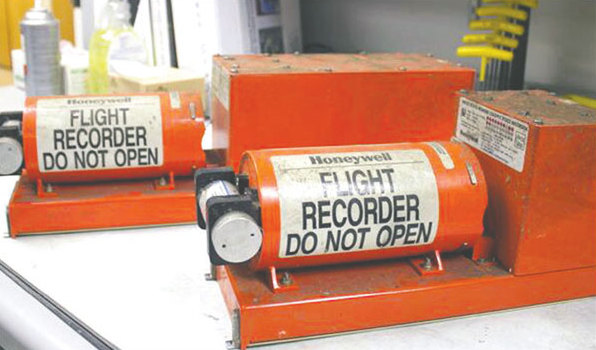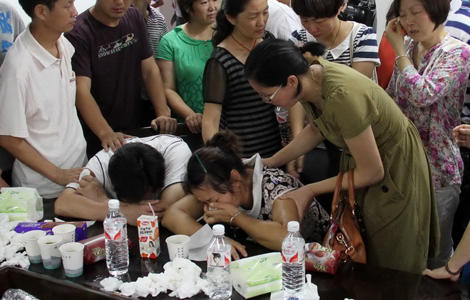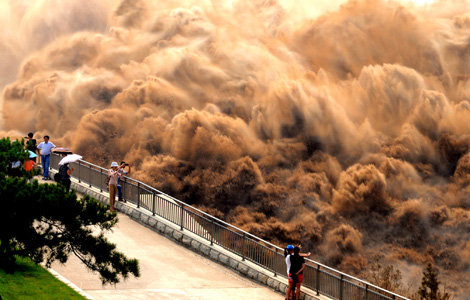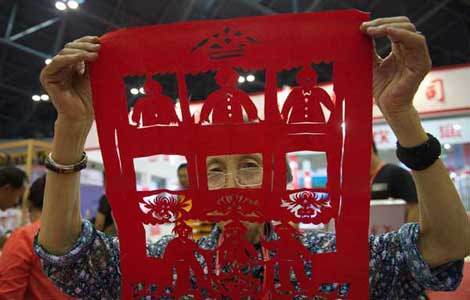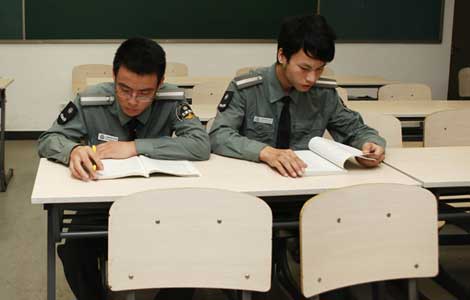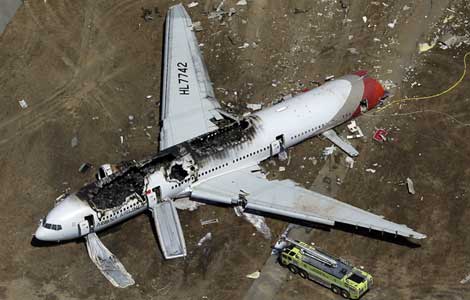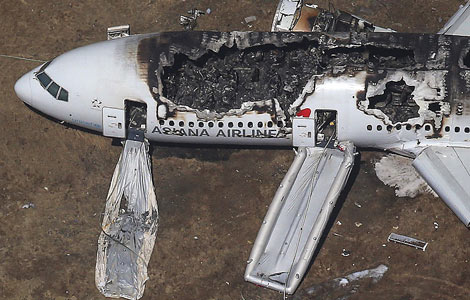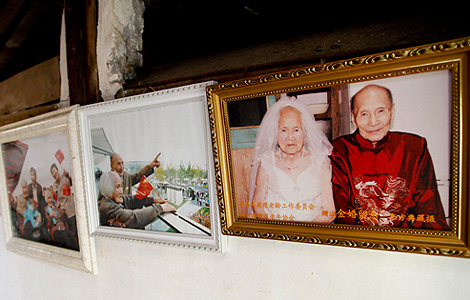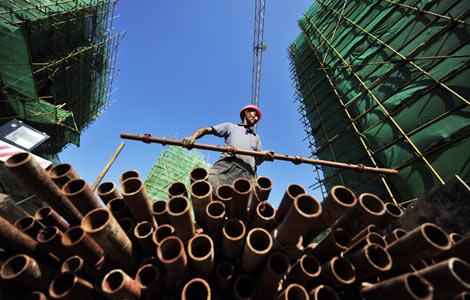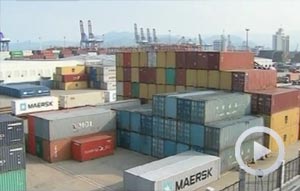NTSB: Plane flew 'below target' speed before crash
Updated: 2013-07-08 11:52
By Caroline Berg in New York (China Daily)
|
||||||||
|
The flight data recorder (left) and cockpit voice recorder, right of the Asiana Flight 214 that crashed in San Francisco on Saturday were shown in Washington on Sunday for investigation. NTSB / AP |
Asiana Airlines Flight 214 was cleared for a visual landing in good weather and its approach appeared routine, until a San Francisco air-traffic controller saw the Boeing 777 hit a seawall that borders the runway and an emergency was declared.
After a last-second attempt by the pilot to abort landing, the impact snapped off part of the jetliner's tail section, and the fuselage burst into flames before the aircraft finally came to a stop at San Francisco International Airport on Saturday, killing two 16-year-old students from China and injuring 182 other people.
One of the two teenagers was apparently ejected and her body was recovered on the runway, near the wreckage of the tail section.
The second girl was found about 30 feet (9 meters) from the plane, near the left wing, some distance from the tail section. Investigators were trying to determine if she had been struck by a firefighting vehicle that responded to the emergency.
Officials of South Korea-based Asiana identified the two as Ye Mengyuan and Wang Linjia, from Jiangshan city, in eastern China's Zhejiang province. They were among a group of about 60 Chinese students who, along with 10 teachers, were en route to pre-college exchange programs in the US. The two girls were on their way to a two-week summer camp in the San Francisco area, according to China's Ministry of Education.
According to Deborah Hersman, chairman of the National Transportation Safety Board, a preliminary analysis of the plane's flight-data and cockpit-voice recorders - both of which had been quickly recovered from the wreckage - indicate the situation in the cockpit on Flight 214 from Shanghai via Seoul was normal, with no discussion of problems or concerns among the crew.
However, seven seconds before impact, a crew member acted to increase the speed, but by then it was too late to correct the approach.
"No prior distress calls or requests for special support or problems were noted in the air traffic control tapes between the controller and the Asiana crew," Hersman said in the first on-scene briefing about a possible cause of Saturday's crash.
Hersman said the preliminary analysis suggested the aircraft was traveling at a speed that was dangerously slow for the conditions. Although the jet's engines had seemed to respond "normally" in the moments before the emergency, pilots let the airspeed reach levels "below target" for the designated approach, she said.
"The [actual] speed was significantly below" the rate of 137 knots (158 miles, or 254 kilometers, per hour), that the crew had reported to air-traffic controllers. "We are not talking about a few knots here or there," the NTSB chief said.
Both recorders were sent to NTSB headquarters in Washington for further analysis in an investigation that could take months.
A stall-warning, in the form of a vibrating "shaker stick", had activated, alarming the flight crew that the plane carrying 307 people - 291 passengers and the 16-member crew - was losing aerodynamic lift just 4.5 seconds before impact. The crew finally tried to increase engine thrust and climb away from the runway to retry the landing, but instead the jet struck a seawall that separates the landing strip from the waters of San Francisco Bay.
The flight had been cleared to land by visual approach, and communications between the crew and cockpit confirmed the aircraft was configured for that, Hersman said in her news conference at the airport.
"The approach proceeded normally as the plane descended," she said, citing the cockpit-recorder data. "There is no discussion of any aircraft anomalies or concerns with the approach."
Stressing that the investigation had only begun, Hersman stopped short of identifying pilot error as a probable cause of the crash.
The preliminary data-based analysis, however, indicates investigators will be focused on understanding why the crew allowed the plane's speed to reach such a slow speed and then failed to take decisive action until the plane was 1.5 seconds from impact.
Over the next few days, Hersman said, the NTSB plans to interview the flight crew and continue other technical investigations to determine the cause.
"I would discourage anyone from drawing any conclusions at this point," she said.
She also said a piece of airport equipment known as a glide slope indicator hadn't been in operation since early June due to runway expansion at San Francisco International, but she said it was premature to reach conclusions. Other systems were available to guide the plane, including color-coded lights, Hersman said.
"We have to identify whether or not the pilots used other tools" and how those tools were functioning at the time, she said.
Hersman said members of South Korea's Accident Investigation Board and Asiana personnel arrived in the US on Sunday to help the NTSB with its investigation.
Passengers on the flight, which originated in Shanghai, included 141 Chinese, 77 South Koreans, 64 Americans, three Indians, three Canadians, one French citizen, one Vietnamese and one Japanese, according to Asiana.
A senior airline official said the flight was piloted by Lee Jeong-min, a veteran pilot who has spent his career with Asiana. He was among four pilots on the plane, who rotated in two-person shifts during the 10-hour flight, the official said.
Airplane escape slides were deployed after the crash-landing and 123 passengers were able to exit well before fire engulfed the fuselage. Many simply walked out of the hole opened in back where the tail had separated.
Another two victims suffered severe road rash after apparently being ejected from the plane, said Margaret Knudson, chief of surgery as San Francisco General Hospital. She said those two patients, who weren't identified, were in critical condition.
Of the 307 passengers and crew members aboard, 182 were taken to local hospitals, including 53 at San Francisco General, Knudson said. Nineteen remained in the hospital on Sunday. Six patients, including one child, were in the intensive-care unit in critical condition; another 13 were in serious or fair condition.
Most of the injured had large abdominal injuries, including visible imprints of seat belts, and there were "huge amounts of spinal fractures," Knudson said.
carolineberg@chinadailyusa.com
(China Daily USA 07/08/2013 page3)
Most Viewed
Editor's Picks

|

|

|
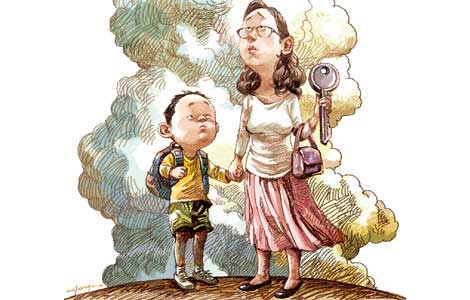
|

|

|
Today's Top News
Boeing 777 passenger 'mumbled a prayer'
Ex-minister gets suspended death
Workers return after dispute
Job seekers should be cautious abroad
River pollution sparks criticism
Terror attack was planned: suspect
Booming security industry needs skilled youth
A bright future for native black pigs?
US Weekly

|

|
